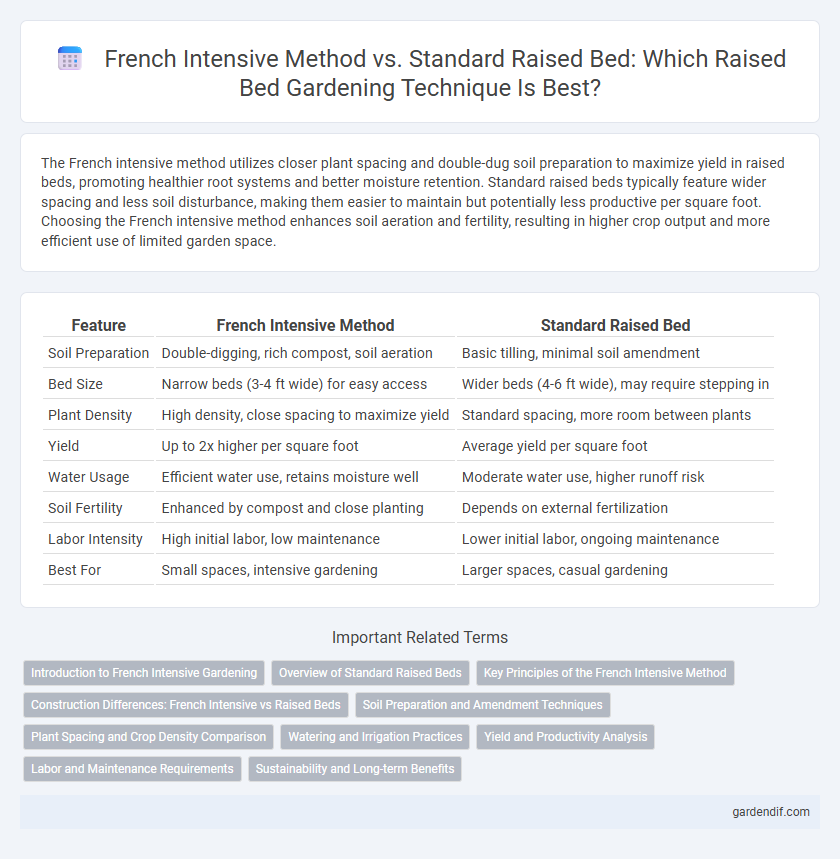
French intensive method vs Standard raised bed Illustration
The French intensive method utilizes closer plant spacing and double-dug soil preparation to maximize yield in raised beds, promoting healthier root systems and better moisture retention. Standard raised beds typically feature wider spacing and less soil disturbance, making them easier to maintain but potentially less productive per square foot. Choosing the French intensive method enhances soil aeration and fertility, resulting in higher crop output and more efficient use of limited garden space.
Table of Comparison
| Feature | French Intensive Method | Standard Raised Bed |
|---|---|---|
| Soil Preparation | Double-digging, rich compost, soil aeration | Basic tilling, minimal soil amendment |
| Bed Size | Narrow beds (3-4 ft wide) for easy access | Wider beds (4-6 ft wide), may require stepping in |
| Plant Density | High density, close spacing to maximize yield | Standard spacing, more room between plants |
| Yield | Up to 2x higher per square foot | Average yield per square foot |
| Water Usage | Efficient water use, retains moisture well | Moderate water use, higher runoff risk |
| Soil Fertility | Enhanced by compost and close planting | Depends on external fertilization |
| Labor Intensity | High initial labor, low maintenance | Lower initial labor, ongoing maintenance |
| Best For | Small spaces, intensive gardening | Larger spaces, casual gardening |
Introduction to French Intensive Gardening
French intensive gardening maximizes crop yield by using raised beds with closely spaced plants and double-digging techniques to improve soil aeration and nutrient availability. This method requires rich, well-amended soil and intensive hand cultivation, contrasting with standard raised beds that often rely on wider plant spacing and simpler soil preparation. French intensive beds promote higher productivity per square foot through careful soil management and planting density optimization.
Overview of Standard Raised Beds
Standard raised beds typically feature a uniform depth of 6 to 12 inches, constructed from materials such as wood, stone, or metal, offering improved drainage and soil aeration compared to in-ground beds. They require moderate soil amendment and maintenance, accommodating a wide range of plants with conventional row spacing. Unlike the French intensive method, standard raised beds prioritize ease of installation and scalability over maximizing planting density.
Key Principles of the French Intensive Method
The French Intensive Method emphasizes deep soil preparation, creating raised beds that are 6 to 12 inches higher than standard beds to improve soil aeration and drainage. It incorporates close plant spacing with companion planting to maximize yield per square foot while enhancing pest control and biodiversity. The method prioritizes compost-rich soil, promoting organic matter integration and reducing the need for chemical fertilizers in comparison to standard raised bed gardening.
Construction Differences: French Intensive vs Raised Beds
French intensive raised beds are constructed with closely spaced planting areas and rich, well-amended soil, emphasizing depth and soil fertility to maximize plant growth. Standard raised beds typically use a simpler, rectangular frame filled with basic soil mixtures, focusing more on defined borders and ease of access rather than soil optimization. The French intensive method often incorporates double digging and organic matter layering, whereas standard raised beds prioritize straightforward assembly and maintenance.
Soil Preparation and Amendment Techniques
The French intensive method emphasizes deep double digging and the addition of rich organic matter, creating a well-aerated, nutrient-dense soil ideal for intensive planting. Standard raised beds typically involve shallow soil preparation with basic amendments like compost or peat moss, resulting in less soil depth and lower fertility compared to the French intensive approach. This method enhances microbial activity and water retention, optimizing plant growth beyond conventional raised bed techniques.
Plant Spacing and Crop Density Comparison
The French intensive method employs closer plant spacing, typically reducing row width and increasing individual plant density to maximize yield per square foot compared to standard raised beds. This approach often achieves up to double the crop density by utilizing narrow spacing patterns and intense soil preparation techniques. In contrast, standard raised beds maintain wider plant spacing to allow ease of access and reduce competition, resulting in lower overall plant density but simpler management.
Watering and Irrigation Practices
The French intensive method requires less frequent watering due to its deep, nutrient-rich compost, which improves soil moisture retention compared to standard raised beds. Standard raised beds often demand more regular irrigation to maintain consistent soil moisture levels, especially in sandy or lightweight soils. Efficient drip irrigation systems paired with mulch help optimize water use in both methods, though the French intensive approach maximizes water efficiency by promoting deeper root growth.
Yield and Productivity Analysis
The French intensive gardening method significantly increases yield per square foot by utilizing close plant spacing and double-digging techniques that improve soil aeration and root growth, resulting in productivity gains of up to 50% compared to standard raised beds. Standard raised beds typically offer better water drainage and soil control but yield lower crop density, limiting total output per area. Yield analysis consistently shows that French intensive beds maximize productivity by optimizing soil structure and nutrient availability for higher-density planting.
Labor and Maintenance Requirements
The French intensive method for raised beds demands significantly more labor upfront due to deep soil preparation, compost integration, and close planting techniques, which enhance soil fertility and crop yield. Standard raised beds require less initial soil amendment and simpler planting, resulting in lower ongoing maintenance and less frequent soil conditioning. While labor-intensive initially, the French intensive method reduces long-term effort through improved soil health, minimizing the need for fertilizers and irrigation compared to standard raised bed systems.
Sustainability and Long-term Benefits
The French intensive method maximizes soil health and crop yields by emphasizing deep soil preparation, close plant spacing, and organic matter enrichment, promoting long-term sustainability through enhanced soil structure and nutrient retention. Standard raised beds often rely on broader spacing and less soil optimization, which can lead to lower productivity and increased need for external inputs over time. Adopting the French intensive approach in raised beds supports sustainable gardening by improving water efficiency, reducing the need for synthetic fertilizers, and fostering resilient plant growth.
French intensive method vs Standard raised bed Infographic

 gardendif.com
gardendif.com